Ringworm (Tinea)
Definition:
Ringworm is a common infection of the skin that is caused by fungus & characterised by itchy red circular rash.
Ringworm is also called “tinea” or “dermatophytosis.”
Dermatophyte infections (ringworm) are extremely common also usually caused by fungi of the Microsporum, Trichophyton and Epidermophyton species.
Furthermore, The fungi can originate from soil (geophilic) or animals (zoophilic), or be confined to human skin (anthropophilic).
In detail, Dermatophyte infections usually present with skin(tinea corporis), scalp (tinea capitis), groin (tinea cruris), foot (tinea pedis) also nail (onychomycosis) involvement. [1]
Besides this, It is called ringworm because the itchy, red rash has a ring-like appearance.
However, ringworm is nothing to do with worms.
It can affect different parts of the body.
The different types of ringworm are usually named for the location of the infection on the body.
Areas of the body that can be affected by ringworm include:
- Feet (i.e. tinea pedis, commonly called “athlete’s foot”)
- Groin, inner thighs, or buttocks (i.e. tinea cruris, commonly called “jock itch”)
- Scalp (i.e. tinea capitis)
- Beard (i.e. tinea barbae)
- Hands (i.e. tinea manuum)
- Toenails or fingernails (i.e. tinea unguium, also called “onychomycosis”)
- Other parts of the body such as arms or legs (i.e. tinea corporis) [4]
Symptoms typically appear between 4 and 14 days after the skin comes in contact with the fungi that cause ringworm.
The symptoms of ringworm often depend on which part of the body is infected, but they generally include:
- Itchy skin
- Ring-shaped rash
- Red, scaly, cracked skin
- Hair loss [3]
Body or skin ringworm (Tinea Corporis):
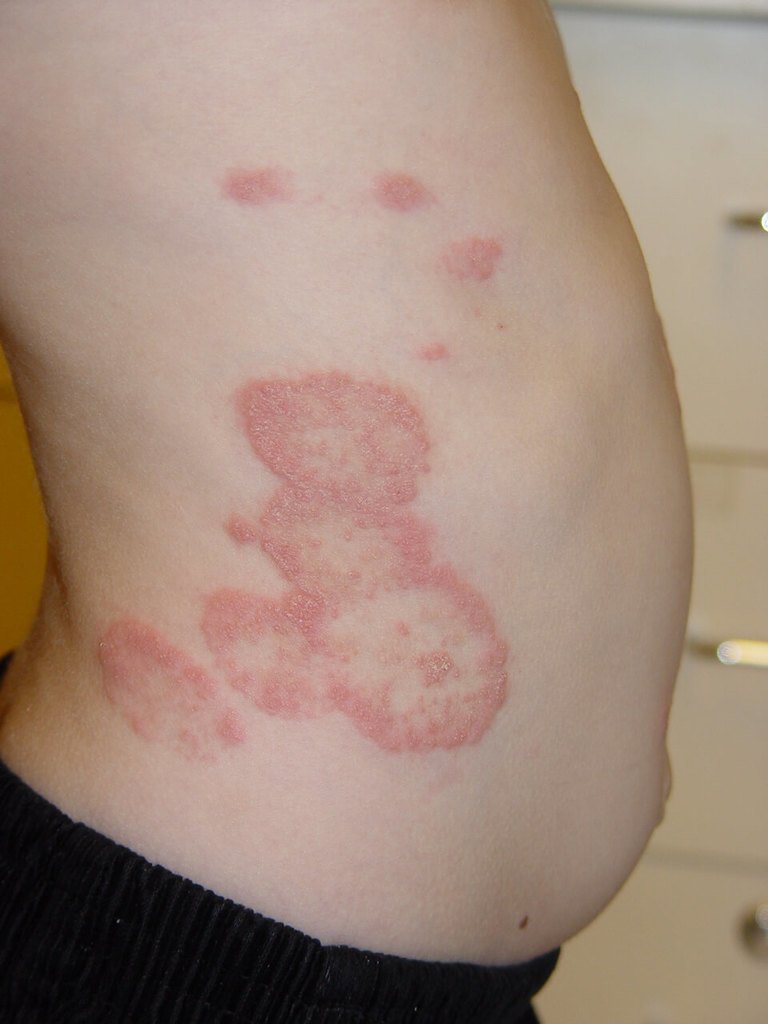
Tinea Corporis
Symptoms include i.e.:
- A rash with a ring-like appearance.
- The skin may be red and inflamed around the outside of the ring, but look fine in the middle.
- Patches can grow slowly, increasing in size and appearing on more areas of the body.
- Merging rings.
- Rings feel slightly raised.
- Itchiness, especially under the rash.
Groin infection (Tinea Cruris/ “Jock Itch”):
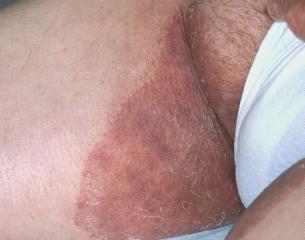
Tinea Cruris
There may be:
- Itchiness, especially in and around the groin.
- Redness and a burning sensation in the affected area.
- Flaky and scaly skin on the inner thighs.
- Symptoms worsen when walking, running, or exercising.
- Tight clothing makes symptoms worse.
Beard area (Tinea Barbae):
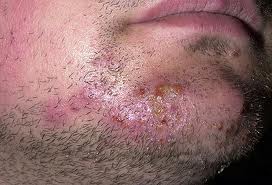
Tinea Barbae
This can involve:
- Redness, swelling, and pus-filled bumps on the cheeks, chin, and upper neck.
- Hair loss, which usually resolves after treatment.
- Swollen glands.
- Raw, open skin and raised, soft, spongy patches that weep.
- Tiredness. [2]
Feet with ringworm infection (Tinea Pedis / Athlete’s Foot):
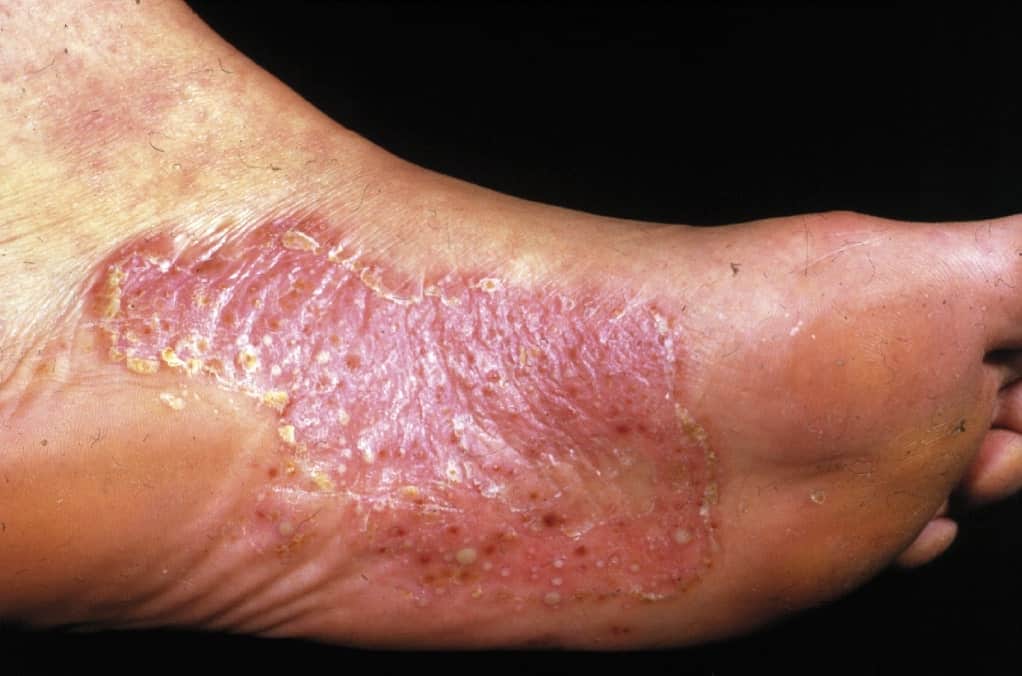
Tinea Pedis
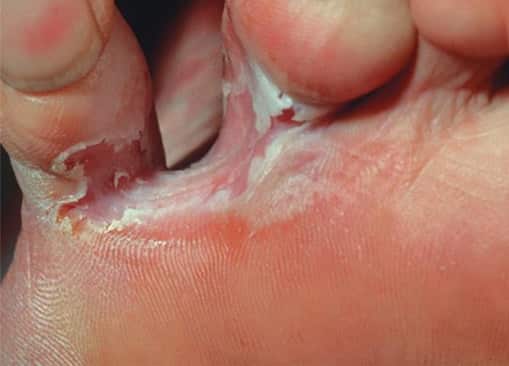
Athlete’s Foot
- Itching, burning, and stinging on your soles also between your toes.
- Dry, scaly skin that usually begins between the toes also can spread to the bottom of the feet, sides, or both.
- Peeling skin
- Blisters, painful cracking skin, bleeding, also thick patches of red and scaly skin.
- Besides this, Skin between the toes turns white, becoming soft and mushy.
- Foul odor.
- Rash on one or both hands because touching the infected foot can spread the infection to your hands.
Nails with ringworm infection (Tinea Unguium / “Onychomycosis”):
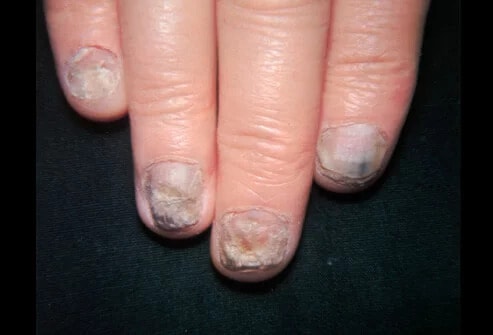
Tinea Unguium
- Can infect 1 or several nails
- Begins with thickening of the tissue under the nail (nail bed).
- Nails discolor and thicken.
- Thickened nails may start to lift away from the nail bed.
- Crumbling nails.
- Disappearing nails (In time, you see less of the nails.)
- Toenails more likely than fingernails to become infected.
- Often develops in people who have athlete’s foot for a long time.
Scalp ringworm (Tinea Capitis):
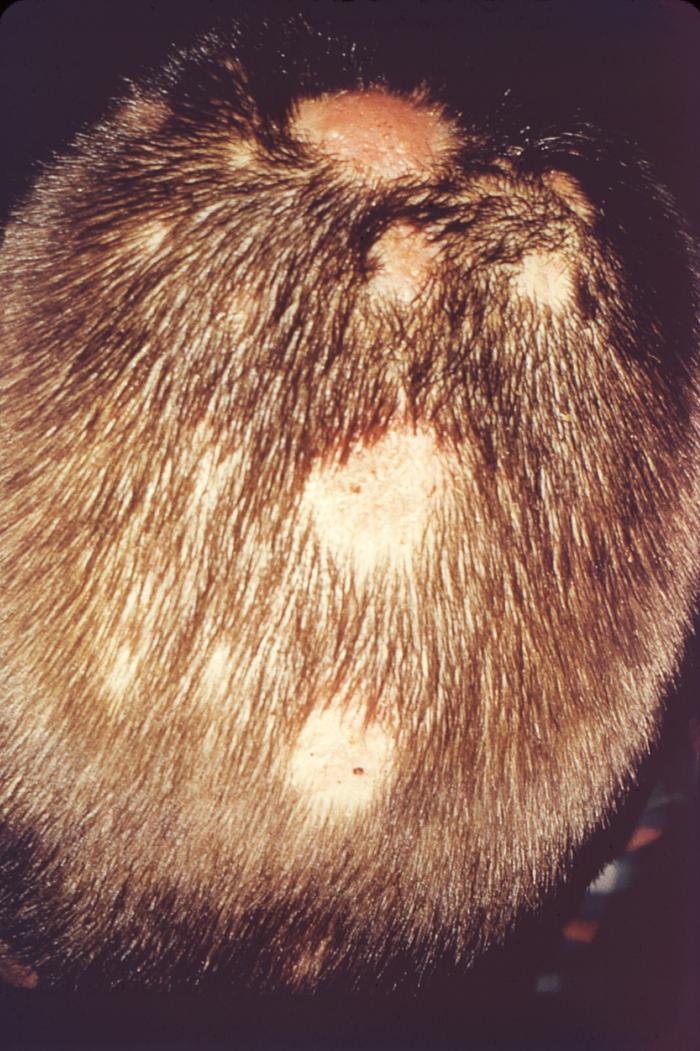
Tinea Capitis
- A scaly bald patch.
- Widespread baldness with thick, crusty patches on the scalp
- Black dots in the bald area.
- Open sores oozing pus.
- Raised soft, spongy, inflamed area.
- Swollen lymph nodes.
- Intense itch. [5]
Certain types of fungi (plural of fungus) cause ringworm.
These fungi thrive where it’s warm and humid.
Ringworm is common in tropical areas and during hot, humid summers.
It flourishes in warm, moist locker rooms and indoor pools.
You can also get ringworm when the weather is cool because ringworm is extremely contagious.
It’s possible to get ringworm from:
- Having skin-to-skin contact with someone who have ringworm.
- Petting an animal like a dog, cat, or farm animal infected with ringworm.
- Touching soil infected with ringworm.
- Using an infected object like a phone, comb, or towel.
Risk Factors:
- Live in a tropical area
- Spend time in hot, humid weather
- Sweat heavily
- Wrestle, play football, or participate in another contact sport
- Live in close contact with others, such as in military housing
- Share towels, clothes, razors, and other things without disinfecting (razors) or washing (clothes and towels) them
- Head-to-head contact can spread scalp ringworm
- Wearing tight clothing
- Obesity
- Have diabetes
The fungi that cause ringworm can live on any infected object, including clothing, brushes, and sports equipment for a long time. [5]
Your doctor will diagnose ringworm by examining your skin and possibly using a black light to view your skin in the affected area.
Depending on the type of fungus, it may sometimes fluoresce (glow) under black light.
Your doctor may confirm a suspected diagnosis of ringworm by requesting certain tests:
- If you’re getting either a skin biopsy or fungal culture, your doctor will take a sample of your skin or discharge from a blister and send it to a lab to test it for the presence of fungus.
- If you’re getting a KOH exam, your doctor will scrape off a small area of infected skin onto a slide and place drops of a liquid called potassium hydroxide (KOH) on it. The KOH breaks apart normal skin cells, making the fungal elements easier to see under a microscope. [3]
Treatment depends on the type of ringworm:
Scalp ringworm:
The most common treatments for scalp ringworm are oral antifungals tablets.
However, the choice of medication will depend on the type of fungi involved.
Terbinafine (Lamisil) i.e.:
- The side effects are normally mild and do not last long.
- They may include diarrhea and nausea.
- People with a history of liver disease should not take terbinafine.
Griseofulvin (Grisovin) i.e.:
- The side effects, which usually go away fairly quickly, may include headache, indigestion, and nausea.
Anti-fungal shampoos i.e.:
- These help prevent the spread of ringworm and may speed up recovery, but they do not cure it.
Shaving a child’s head i.e.:
- There is no evidence that this reduces ringworm infection or accelerates recovery time.
Skin ringworm and groin infection:
- Generally, Most cases are treated with antifungal creams.
- Moreover, If symptoms are severe, or if they cover a large area of the body and do not respond to OTC (Over the Counter) medications, the doctor may prescribe a prescription-strength topical medication.
- Besides this, The doctor may prescribe an oral medication (taken by mouth).
- Lastly, Oral medications can have some side effects, including stomach upset, rash, or abnormal liver function.
Caring for the skin during infection:
Care for the skin properly can help speed recovery.
- Wash the skin gently.
- Dry the skin thoroughly but gently.
- Pat the skin with a towel in tender areas, but do not rub.
- Make sure any folds also areas between the toes are dried thoroughly.
- Change either sock or underwear more often than usual if they cover an infected area.
- Always treat the feet and groin at the same time, as infection often spreads from one area to another.
- Where possible, wear loose-fitting clothing also undergarments, such as boxers.
People have used home remedies for ringworm for many years before researchers invented antifungal treatments.
Support for use of these remedies is mostly anecdotal.
There is no scientific data to support their use over OTC antifungals.
Home Remedies:
These treatments include:
Apple cider vinegar i.e.:
- Basically, Some people apply apple cider vinegar-soaked cotton balls over affected areas of skin three times a day to treat ringworm.
Coconut oil i.e.:
- Coconut oil isn’t just for cooking people apply it to their skin to reduce the incidence of ringworm infections.
- Additionally, If you want to try this remedy, apply coconut oil one to three times a day.
Turmeric i.e.
- First of all, Turmeric is a spice you can mix with water to make an antifungal paste.
- In detail, Apply the paste directly to your skin and allow it to dry. [3]
Homeopathic treatment for Ringworm is natural, safe and without any side-effects, and one can enjoy immense relief from these frustrating symptoms.
It is a patient-oriented science and medicines are prescribed on the characteristics of the individual rather than just the symptoms of the disease.
Sepia – for ringworm in isolated spots:
- It is the top natural remedy especially for ringworm infection appearing in isolated spots.
- Although the ringworm lesion for using sepia can be noticed on any part of the body, additionally the common location is the bends of the knee and elbow.
- The eruptions are accompanied by itching and scratching, though scratching does not provide any relief.
- Apart from these symptoms, increased sweating with or without a bad smell may be noticed in persons requiring Sepia.
- Another peculiar symptom for using sepia is the recurrence of ringworm infection in every spring season.
- Sepia can help in eradicating the tendency to have a ringworm infection every time the spring season approaches.
- High sensitivity towards cold air may be found with these symptoms.
- The mental symptoms of utmost importance while recommending sepia are irritability and indifferent behavior towards family, friends, and life.
Tellurium – for ringworm infection with lesions on large part of body:
- Tellurium is the best natural medicine when ringworm eruptions cover a large part of the body.
- Here, the ringworm lesions join one another and eventually cover a large area of skin.
- Moreover, The body is densely covered with intersecting ring lesions.
- In detail, The ringworm eruptions with clear margins are easily detectable on an increased surface of the skin for using tellurium.
- Eruptions are marked by excessive itching and stinging sensation.
- The itching remains present throughout day also night.
- Besides this, Cold air seems to worsen the itching.
- All in all, An offensive smell from the area covered with ringworm eruptions is frequently noticed.
Sulphur – for intense itching and burning:
- In treating ringworm lesions also, sulphur is quite successful.
- The main complaint described by ringworm patients that helps in selecting sulphur is intense itching also burning in eruptions.
- The person goes on scratching the lesions but it does not seem to provide any relief.
- Only the intense burning sensation follows scratching.
- Additionally, The itching is heightened at night in most patients who can benefit from sulphur.
- It is also of great help in all cases of ringworm appearing on limbs, scalp, trunk, and face when accompanied by intense itching and burning.
- This remedy specifically helps to soothe the itching and burning, followed by the disappearance of eruptions.
- Sulphur is a deep acting natural remedy that can help in root extraction of ringworm lesions if used for some time.
- Lastly, It should always be the first Homeopathic choice in those cases of ringworm that have been suppressed with local medications of varying kinds.
Psorinum – for Ringworm (Tinea) on scalp and bends of joints:
- Psorinum is an excellent skin remedy used for the treatment of ringworm.
- It is mainly used for ringworm infection of scalp also bends of joints.
- Furthermore, The eruptions are excessively itching.
- In most cases, the itching is enhanced in bed due to warmth.
- Hair loss is the key noticeable feature for using natural remedy psorinum for ringworm of the scalp (Tinea Capitis).
- In a few cases, the hair appears dry, rough also lustreless.
- Another key symptom is profuse sweating with bad odour throughout the body.
- High sensitivity to cold air is another prominent symptom to be noted for using Psorinum.
- The persons needing psorinum cannot tolerate cold air even in summer weather.
Arsenic Album – for scalp Ringworm (Tinea):
- It is a very beneficial natural remedy for ringworm of scalp.
- The scalp shows bald spots with intolerable itching.
- The scalp is rough and dry.
- Along with itching, there is an intense burning sensation.
- The symptoms of itching and burning are most markedly disturbing at night.
- Arsenic Album helps in all spheres to reduce itching, burning and also helps in regrowth of hair on bald spots.
- Apart from these local symptoms, a few general symptoms are also to be taken into account in selecting Arsenic Album for Tinea Capitis.
- The first is acute anxiety.
- The second is extreme restlessness.
- The next is fastidiousness with a desire for clean surroundings and objects to be placed at a proper place.
- Thirst for a small quantity of water at very short intervals is another important symptom which is significant for selecting arsenic album. [6]
Frequently Asked Questions
What is Ringworm?
Ringworm is a common infection of the skin that is caused by fungus & characterised by itchy red circular rash. Ringworm is also called “tinea” or “dermatophytosis.”
Homeopathic Medicines used by Homeopathic Doctors in treatment of Ringworm?
- Sepia
- Tellurium
- Sulphur
- Psorinum
- Arsenic Album
What causes Ringworm?
- Fungi
- Skin-to-skin contact
- Animal infected with ringworm
- Touching soil infected
- Using an infected object
What are the symptoms of Ringworm?
- Itchy skin
- Ring-shaped rash
- Red, scaly, cracked skin
- Hair loss
Give the types of Ringworm ?
- Tinea pedis
- Tinea cruris
- Tinea capitis
- Tinea barbae
- Tinea manuum
- Tinea unguium
- Tinea corporis
- Davidson’s Principles and Practice of Medicine (22nd edition) Ch. 28
- https://www.medicalnewstoday.com/articles/158004.php
- https://www.healthline.com/health/ringworm#pictures
- https://www.cdc.gov/fungal/diseases/ringworm/diagnosis.html
- https://www.aad.org/public/diseases/contagious-skin-diseases/ringworm#treatment
- https://www.drhomeo.com/homeopathic-treatment/homeopathic-medicine-ringworms/
Definition:
Ringworm is a common infection of the skin that is caused by fungus & characterised by itchy red circular rash.
Ringworm is also called “tinea” or “dermatophytosis.”
Overview
Epidemiology
Causes
Risk Factors
Pathogenesis
Pathophysiology
Types
Clinical Features
Sign & Symptoms
Clinical Examination
Diagnosis
Differential Diagnosis
Complications
Investigations
Treatment
Prevention
Homeopathic Treatment
Diet & Regimen
Do’s and Dont’s
Terminology
References
FAQ
Also Search As
Overview
Dermatophyte infections (ringworm) are extremely common also usually caused by fungi of the Microsporum, Trichophyton and Epidermophyton species.
Furthermore, The fungi can originate from soil (geophilic) or animals (zoophilic), or be confined to human skin (anthropophilic).
In detail, Dermatophyte infections usually present with skin(tinea corporis), scalp (tinea capitis), groin (tinea cruris), foot (tinea pedis) also nail (onychomycosis) involvement. [1]
Besides this, It is called ringworm because the itchy, red rash has a ring-like appearance.
However, ringworm is nothing to do with worms.
It can affect different parts of the body.
Epidemiology
Indian epidemiology then other
Causes
Certain types of fungi (plural of fungus) cause ringworm.
These fungi thrive where it’s warm and humid.
Ringworm is common in tropical areas and during hot, humid summers.
It flourishes in warm, moist locker rooms and indoor pools.
You can also get ringworm when the weather is cool because ringworm is extremely contagious.
It’s possible to get ringworm from:
- Having skin-to-skin contact with someone who have ringworm.
- Petting an animal like a dog, cat, or farm animal infected with ringworm.
- Touching soil infected with ringworm.
- Using an infected object like a phone, comb, or towel.
Risk Factors:
- Live in a tropical area
- Spend time in hot, humid weather
- Sweat heavily
- Wrestle, play football, or participate in another contact sport
- Live in close contact with others, such as in military housing
- Share towels, clothes, razors, and other things without disinfecting (razors) or washing (clothes and towels) them
- Head-to-head contact can spread scalp ringworm
- Wearing tight clothing
- Obesity
- Have diabetes
The fungi that cause ringworm can live on any infected object, including clothing, brushes, and sports equipment for a long time. [5]
Risk Factors
Risk factors are things that make you more likely to develop a disease in the first place.
Pathogenesis
Pathogenesis refers to the development of a disease. It’s the story of how a disease gets started and progresses.
This is the entire journey of a disease, encompassing the cause but going beyond it.
Pathophysiology
Pathophysiology, on the other hand, focuses on the functional changes that occur in the body due to the disease. It explains how the disease disrupts normal physiological processes and how this disruption leads to the signs and symptoms we see.
Imagine a car accident. Pathogenesis would be like understanding how the accident happened – what caused it, the sequence of events (e.g., one car ran a red light, then hit another car). Pathophysiology would be like understanding the damage caused by the accident – the bent fenders, deployed airbags, and any injuries to the passengers.
In simpler terms, pathogenesis is about the "why" of a disease, while pathophysiology is about the "how" of the disease’s effects.
Types
The different types of ringworm are usually named for the location of the infection on the body.
Areas of the body that can be affected by ringworm include:
- Feet (i.e. tinea pedis, commonly called “athlete’s foot”)
- Groin, inner thighs, or buttocks (i.e. tinea cruris, commonly called “jock itch”)
- Scalp (i.e. tinea capitis)
- Beard (i.e. tinea barbae)
- Hands (i.e. tinea manuum)
- Toenails or fingernails (i.e. tinea unguium, also called “onychomycosis”)
- Other parts of the body such as arms or legs (i.e. tinea corporis) [4]
Clinical Features
Tab Content
Sign & Symptoms
Symptoms typically appear between 4 and 14 days after the skin comes in contact with the fungi that cause ringworm.
The symptoms of ringworm often depend on which part of the body is infected, but they generally include:
- Itchy skin
- Ring-shaped rash
- Red, scaly, cracked skin
- Hair loss [3]
Body or skin ringworm (Tinea Corporis):

Tinea Corporis
Symptoms include i.e.:
- A rash with a ring-like appearance.
- The skin may be red and inflamed around the outside of the ring, but look fine in the middle.
- Patches can grow slowly, increasing in size and appearing on more areas of the body.
- Merging rings.
- Rings feel slightly raised.
- Itchiness, especially under the rash.
Groin infection (Tinea Cruris/ “Jock Itch”):

Tinea Cruris
There may be:
- Itchiness, especially in and around the groin.
- Redness and a burning sensation in the affected area.
- Flaky and scaly skin on the inner thighs.
- Symptoms worsen when walking, running, or exercising.
- Tight clothing makes symptoms worse.
Beard area (Tinea Barbae):

Tinea Barbae
This can involve:
- Redness, swelling, and pus-filled bumps on the cheeks, chin, and upper neck.
- Hair loss, which usually resolves after treatment.
- Swollen glands.
- Raw, open skin and raised, soft, spongy patches that weep.
- Tiredness. [2]
Feet with ringworm infection (Tinea Pedis / Athlete’s Foot):

Tinea Pedis

Athlete’s Foot
- Itching, burning, and stinging on your soles also between your toes.
- Dry, scaly skin that usually begins between the toes also can spread to the bottom of the feet, sides, or both.
- Peeling skin
- Blisters, painful cracking skin, bleeding, also thick patches of red and scaly skin.
- Besides this, Skin between the toes turns white, becoming soft and mushy.
- Foul odor.
- Rash on one or both hands because touching the infected foot can spread the infection to your hands.
Nails with ringworm infection (Tinea Unguium / “Onychomycosis”):

Tinea Unguium
- Can infect 1 or several nails
- Begins with thickening of the tissue under the nail (nail bed).
- Nails discolor and thicken.
- Thickened nails may start to lift away from the nail bed.
- Crumbling nails.
- Disappearing nails (In time, you see less of the nails.)
- Toenails more likely than fingernails to become infected.
- Often develops in people who have athlete’s foot for a long time.
Scalp ringworm (Tinea Capitis):

Tinea Capitis
- A scaly bald patch.
- Widespread baldness with thick, crusty patches on the scalp
- Black dots in the bald area.
- Open sores oozing pus.
- Raised soft, spongy, inflamed area.
- Swollen lymph nodes.
- Intense itch. [5]
Clinical Examination
Tab Content
Diagnosis
Your doctor will diagnose ringworm by examining your skin and possibly using a black light to view your skin in the affected area.
Depending on the type of fungus, it may sometimes fluoresce (glow) under black light.
Your doctor may confirm a suspected diagnosis of ringworm by requesting certain tests:
- If you’re getting either a skin biopsy or fungal culture, your doctor will take a sample of your skin or discharge from a blister and send it to a lab to test it for the presence of fungus.
- If you’re getting a KOH exam, your doctor will scrape off a small area of infected skin onto a slide and place drops of a liquid called potassium hydroxide (KOH) on it. The KOH breaks apart normal skin cells, making the fungal elements easier to see under a microscope. [3]
Differential Diagnosis
Complications
Complications are what happen after you have a disease. They are the negative consequences of the disease process.
Investigations
Tab Content
Treatment
Treatment depends on the type of ringworm:
Scalp ringworm:
The most common treatments for scalp ringworm are oral antifungals tablets.
However, the choice of medication will depend on the type of fungi involved.
Terbinafine (Lamisil) i.e.:
- The side effects are normally mild and do not last long.
- They may include diarrhea and nausea.
- People with a history of liver disease should not take terbinafine.
Griseofulvin (Grisovin) i.e.:
- The side effects, which usually go away fairly quickly, may include headache, indigestion, and nausea.
Anti-fungal shampoos i.e.:
- These help prevent the spread of ringworm and may speed up recovery, but they do not cure it.
Shaving a child’s head i.e.:
- There is no evidence that this reduces ringworm infection or accelerates recovery time.
Skin ringworm and groin infection:
- Generally, Most cases are treated with antifungal creams.
- Moreover, If symptoms are severe, or if they cover a large area of the body and do not respond to OTC (Over the Counter) medications, the doctor may prescribe a prescription-strength topical medication.
- Besides this, The doctor may prescribe an oral medication (taken by mouth).
- Lastly, Oral medications can have some side effects, including stomach upset, rash, or abnormal liver function.
Caring for the skin during infection:
Care for the skin properly can help speed recovery.
- Wash the skin gently.
- Dry the skin thoroughly but gently.
- Pat the skin with a towel in tender areas, but do not rub.
- Make sure any folds also areas between the toes are dried thoroughly.
- Change either sock or underwear more often than usual if they cover an infected area.
- Always treat the feet and groin at the same time, as infection often spreads from one area to another.
- Where possible, wear loose-fitting clothing also undergarments, such as boxers.
People have used home remedies for ringworm for many years before researchers invented antifungal treatments.
Support for use of these remedies is mostly anecdotal.
There is no scientific data to support their use over OTC antifungals.
Home Remedies:
These treatments include:
Apple cider vinegar i.e.:
- Basically, Some people apply apple cider vinegar-soaked cotton balls over affected areas of skin three times a day to treat ringworm.
Coconut oil i.e.:
- Coconut oil isn’t just for cooking people apply it to their skin to reduce the incidence of ringworm infections.
- Additionally, If you want to try this remedy, apply coconut oil one to three times a day.
Turmeric i.e.
- First of all, Turmeric is a spice you can mix with water to make an antifungal paste.
- In detail, Apply the paste directly to your skin and allow it to dry. [3]
Prevention
Tab Content
Homeopathic Treatment
Homeopathic treatment for Ringworm is natural, safe and without any side-effects, and one can enjoy immense relief from these frustrating symptoms.
It is a patient-oriented science and medicines are prescribed on the characteristics of the individual rather than just the symptoms of the disease.
Sepia – for ringworm in isolated spots:
- It is the top natural remedy especially for ringworm infection appearing in isolated spots.
- Although the ringworm lesion for using sepia can be noticed on any part of the body, additionally the common location is the bends of the knee and elbow.
- The eruptions are accompanied by itching and scratching, though scratching does not provide any relief.
- Apart from these symptoms, increased sweating with or without a bad smell may be noticed in persons requiring Sepia.
- Another peculiar symptom for using sepia is the recurrence of ringworm infection in every spring season.
- Sepia can help in eradicating the tendency to have a ringworm infection every time the spring season approaches.
- High sensitivity towards cold air may be found with these symptoms.
- The mental symptoms of utmost importance while recommending sepia are irritability and indifferent behavior towards family, friends, and life.
Tellurium – for ringworm infection with lesions on large part of body:
- Tellurium is the best natural medicine when ringworm eruptions cover a large part of the body.
- Here, the ringworm lesions join one another and eventually cover a large area of skin.
- Moreover, The body is densely covered with intersecting ring lesions.
- In detail, The ringworm eruptions with clear margins are easily detectable on an increased surface of the skin for using tellurium.
- Eruptions are marked by excessive itching and stinging sensation.
- The itching remains present throughout day also night.
- Besides this, Cold air seems to worsen the itching.
- All in all, An offensive smell from the area covered with ringworm eruptions is frequently noticed.
Sulphur – for intense itching and burning:
- In treating ringworm lesions also, sulphur is quite successful.
- The main complaint described by ringworm patients that helps in selecting sulphur is intense itching also burning in eruptions.
- The person goes on scratching the lesions but it does not seem to provide any relief.
- Only the intense burning sensation follows scratching.
- Additionally, The itching is heightened at night in most patients who can benefit from sulphur.
- It is also of great help in all cases of ringworm appearing on limbs, scalp, trunk, and face when accompanied by intense itching and burning.
- This remedy specifically helps to soothe the itching and burning, followed by the disappearance of eruptions.
- Sulphur is a deep acting natural remedy that can help in root extraction of ringworm lesions if used for some time.
- Lastly, It should always be the first Homeopathic choice in those cases of ringworm that have been suppressed with local medications of varying kinds.
Psorinum – for Ringworm (Tinea) on scalp and bends of joints:
- Psorinum is an excellent skin remedy used for the treatment of ringworm.
- It is mainly used for ringworm infection of scalp also bends of joints.
- Furthermore, The eruptions are excessively itching.
- In most cases, the itching is enhanced in bed due to warmth.
- Hair loss is the key noticeable feature for using natural remedy psorinum for ringworm of the scalp (Tinea Capitis).
- In a few cases, the hair appears dry, rough also lustreless.
- Another key symptom is profuse sweating with bad odour throughout the body.
- High sensitivity to cold air is another prominent symptom to be noted for using Psorinum.
- The persons needing psorinum cannot tolerate cold air even in summer weather.
Arsenic Album – for scalp Ringworm (Tinea):
- It is a very beneficial natural remedy for ringworm of scalp.
- The scalp shows bald spots with intolerable itching.
- The scalp is rough and dry.
- Along with itching, there is an intense burning sensation.
- The symptoms of itching and burning are most markedly disturbing at night.
- Arsenic Album helps in all spheres to reduce itching, burning and also helps in regrowth of hair on bald spots.
- Apart from these local symptoms, a few general symptoms are also to be taken into account in selecting Arsenic Album for Tinea Capitis.
- The first is acute anxiety.
- The second is extreme restlessness.
- The next is fastidiousness with a desire for clean surroundings and objects to be placed at a proper place.
- Thirst for a small quantity of water at very short intervals is another important symptom which is significant for selecting arsenic album. [6]
Diet & Regimen
Do’s and Dont’s
Tab Content
Terminology
Tab Content
References
- Davidson’s Principles and Practice of Medicine (22nd edition) Ch. 28
- https://www.medicalnewstoday.com/articles/158004.php
- https://www.healthline.com/health/ringworm#pictures
- https://www.cdc.gov/fungal/diseases/ringworm/diagnosis.html
- https://www.aad.org/public/diseases/contagious-skin-diseases/ringworm#treatment
- https://www.drhomeo.com/homeopathic-treatment/homeopathic-medicine-ringworms/
FAQ
Frequently Asked Questions
What is Ringworm?
Ringworm is a common infection of the skin that is caused by fungus & characterised by itchy red circular rash. Ringworm is also called “tinea” or “dermatophytosis.”
Homeopathic Medicines used by Homeopathic Doctors in treatment of Ringworm?
- Sepia
- Tellurium
- Sulphur
- Psorinum
- Arsenic Album
What causes Ringworm?
- Fungi
- Skin-to-skin contact
- Animal infected with ringworm
- Touching soil infected
- Using an infected object
What are the symptoms of Ringworm?
- Itchy skin
- Ring-shaped rash
- Red, scaly, cracked skin
- Hair loss
Give the types of Ringworm ?
- Tinea pedis
- Tinea cruris
- Tinea capitis
- Tinea barbae
- Tinea manuum
- Tinea unguium
- Tinea corporis
Also Search As
Frequently Asked Questions (FAQ)
XYZ
XXX
XYZ
XXX
XYZ
XXX
How can I find reputable homeopathy clinics or homeopathic doctors in my area?
You can found Homeopathic Clinic For XXXX by searching for
Specific city Examples are
You can also search for near you Examples are














































































































































































































































































































